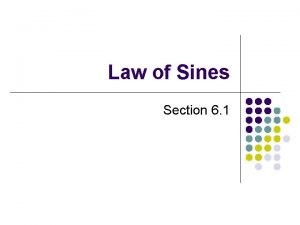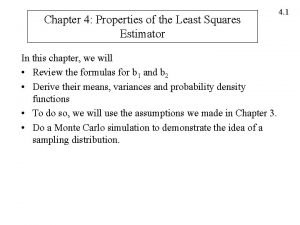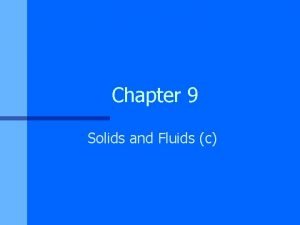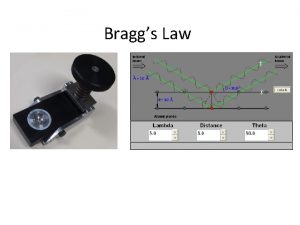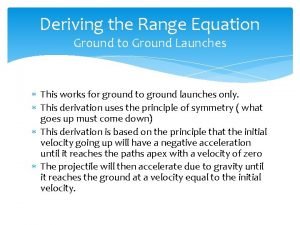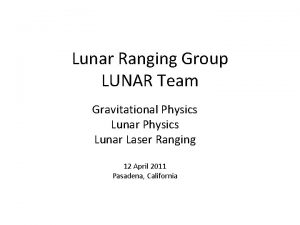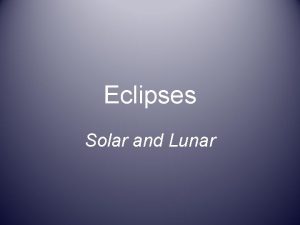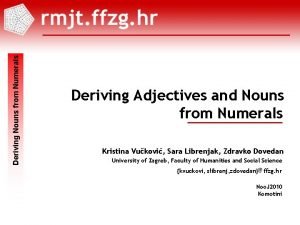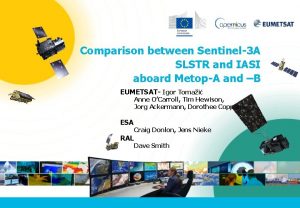Deriving lunar irradiances from SLSTR lunar acquisition Preliminary




![Moon data geometric calibration MOON L 0 data dimensions: [acrosstrack, detector, read cycle, alongtrack] Moon data geometric calibration MOON L 0 data dimensions: [acrosstrack, detector, read cycle, alongtrack]](https://slidetodoc.com/presentation_image_h/128f8d8040b7c35aa1682fcfee097102/image-5.jpg)

![Moon Irradiance measured with SLSTR [m. W m-2 nm-1] 7 Moon Irradiance measured with SLSTR [m. W m-2 nm-1] 7](https://slidetodoc.com/presentation_image_h/128f8d8040b7c35aa1682fcfee097102/image-7.jpg)



- Slides: 10

Deriving lunar irradiances from SLSTR lunar acquisition. Preliminary analysis and results. Mireya Etxaluze, Maciej Neneman, Dave Smith, Sebastien Wagner, Ed Polehampton, Jens Nieke

SLSTR Basic Geometry SLSTR observes two views of the Earth: A nadir view (1400 km) An inclined oblique view (740 km) A scanning mirror is used for each view and a flip mirror to switch between them Internal calibration sources (two BBs) are viewed once in each cycle of two scans. The calibration for the visible channels is based on a diffuser based calibration VISCAL system which is illuminated by the sun over a short segment of the orbit. The VISCAL signal provides a calibration reference to convert the measured signal in each channel to the surface reflectance. 2

SLSTR VIS-SWIR channels calibration analysis The SLSTR VISCAL reflectance was characterized during on-ground calibration. Once in-orbit, analysis performed by different groups over stable desert sites show good agreement wrt. reference sensor, for S 1 -S 3 in nadir view. S 5 -S 6 show 12% offset. Users are advised to apply correction factors: The root cause is still under investigation. Channel S 4 at 1370 nm has no vicarious adjustment as it is in water vapour line Lunar observations were made to use the moon data and lunar models for characterisation and validation of SLSTR. 3

Moon observations SLSTR L 0 quicklook generated from the Moon observation. The image shows the view from spacecraft rotating away and towards the Earth. The Moon data acquisition took place in a stable orientation after a roll manoeuvre, allowing the Moon to be mapped by the SLSTR instrument. Along-track SLSTR orbit S 3 B SLSTR observation was made on 07/2018 S 3 A SLSTR observation was made on 07/2020 SLSTR observed the Moon in nadir view with all the channels: the VIS (S 1 -S 3), the SWIR (S 4 -S 6) and the TIR (S 7 -S 9). Across-track Along-track Channel S 1 SLSTR also conducted a cold sky observation to provide an additional calibration point using the channels S 8 and S 9. Across-track 4
![Moon data geometric calibration MOON L 0 data dimensions acrosstrack detector read cycle alongtrack Moon data geometric calibration MOON L 0 data dimensions: [acrosstrack, detector, read cycle, alongtrack]](https://slidetodoc.com/presentation_image_h/128f8d8040b7c35aa1682fcfee097102/image-5.jpg)
Moon data geometric calibration MOON L 0 data dimensions: [acrosstrack, detector, read cycle, alongtrack] Channel S 1 SLSTR VIS channels 4 detectors (1 array) SLSTR SWIR channels 8 detectors (2 arrays) SLSTR VIS/SWIR channels: 2 read cycles Pixel size=[4. 3’, 1’] det 1 det 2 det 3 det 4 Channel S 1 Detector 1 Triangulation of L 0 data for interpolation into a regular grid Two read-cycles are merged One image per detector. Across-track Along-track SLSTR-B NEXT: One image per channel. Across-track Pixel size=[1’, 1’] Along-track 5

Moon data radiometric calibration The SLSTR Moon data consist of: Re-mapped L 0 Nadir view data [DN] Dark signal measured at dark sky Channel S 1 Detector 1 VISCAL file of the orbit VISCAL signal [DN] BB measured signal [DN] Auxiliary data files Solar irradiance [m. W m-2 nm-1] VISCAL reflectance factors LUT with non-linearity curves 6
![Moon Irradiance measured with SLSTR m W m2 nm1 7 Moon Irradiance measured with SLSTR [m. W m-2 nm-1] 7](https://slidetodoc.com/presentation_image_h/128f8d8040b7c35aa1682fcfee097102/image-7.jpg)
Moon Irradiance measured with SLSTR [m. W m-2 nm-1] 7

Moon Irradiance measured with SLSTR wrt LIME S 3 B vicarious corrected S 3 B LIME Observation/model S 3 B vicarious corrected S 3 B LIME These are very preliminary results. VIS channels: • S 3 B observations agree the LIME models in a 2% when the vicarious correction is not applied • The Vicarious calibration increases the difference between measurements and LIME models up to 4% S 4 channel: • S 3 B observations agree the LIME models in a 1. 5% • There is not a vicarious calibration. This channel is for cloud detection SWIR channels • S 5 agrees with the LIME models in a 0. 5%, while S 6 is ~10% lower than the models • The vicarious calibration corrects S 6 up to 2% , while increases the difference up to 11% for S 5 8

Summary 9

10
 Second language vs foreign language
Second language vs foreign language Listening for deriving aesthetic pleasure ? *
Listening for deriving aesthetic pleasure ? * Deriving law of sines
Deriving law of sines Maxwell relations thermodynamics
Maxwell relations thermodynamics Bernoulli's law
Bernoulli's law State the properties of least square estimators
State the properties of least square estimators Bernoulli equation derivation
Bernoulli equation derivation Braggs law
Braggs law Deriving the range equation
Deriving the range equation Mla thesis example
Mla thesis example Preliminary cooking and flavoring
Preliminary cooking and flavoring


